Business Research Proposal: Strategic Leadership and Abu Dhabi Vision
VerifiedAdded on 2020/05/28
|15
|3438
|433
Report
AI Summary
This research proposal investigates the critical role of strategic leadership in fostering innovative practices within the public sector, with a specific focus on the Abu Dhabi Vision 2030. The study aims to explore how strategic leadership can enhance the financial performance and promote innovation in the public sector of Abu Dhabi, aligning with the vision for 2030. The proposal includes a comprehensive literature review, examining the existing research on strategic leadership and innovation, particularly within the context of public sector reform and the UAE's strategic goals. The research methodology utilizes an exploratory research design and a deductive approach, relying on secondary data sources such as peer-reviewed journals, books, and government reports. The proposal outlines the research questions, methodology, ethical considerations, and anticipated outcomes, providing a structured framework for investigating the impact of strategic leadership on the public sector's ability to adapt, innovate, and achieve its long-term strategic objectives. The study also addresses potential challenges and the importance of implementing innovative practices through strategic leadership to ensure balanced company performance and control.

Running head: BUSINESS RESEARCH METHOD PROPOSAL
BUSINESS RESEARCH METHOD PROPOSAL
Name of the Student
Name of the University
Author’s Note
BUSINESS RESEARCH METHOD PROPOSAL
Name of the Student
Name of the University
Author’s Note
Paraphrase This Document
Need a fresh take? Get an instant paraphrase of this document with our AI Paraphraser

1BUSINESS RESEARCH METHOD PROPOSAL
Table of Contents
Overview..........................................................................................................................................3
Research Questions..........................................................................................................................4
Literature Review............................................................................................................................4
Research Methodology....................................................................................................................7
Research process..........................................................................................................................7
Research philosophy....................................................................................................................8
Research Design..........................................................................................................................8
Research Approach......................................................................................................................9
Research Method.......................................................................................................................10
Ethical Issues.............................................................................................................................10
Outcomes.......................................................................................................................................11
Timescale.......................................................................................................................................11
Conclusion and Recommendation.................................................................................................12
References......................................................................................................................................13
Table of Contents
Overview..........................................................................................................................................3
Research Questions..........................................................................................................................4
Literature Review............................................................................................................................4
Research Methodology....................................................................................................................7
Research process..........................................................................................................................7
Research philosophy....................................................................................................................8
Research Design..........................................................................................................................8
Research Approach......................................................................................................................9
Research Method.......................................................................................................................10
Ethical Issues.............................................................................................................................10
Outcomes.......................................................................................................................................11
Timescale.......................................................................................................................................11
Conclusion and Recommendation.................................................................................................12
References......................................................................................................................................13
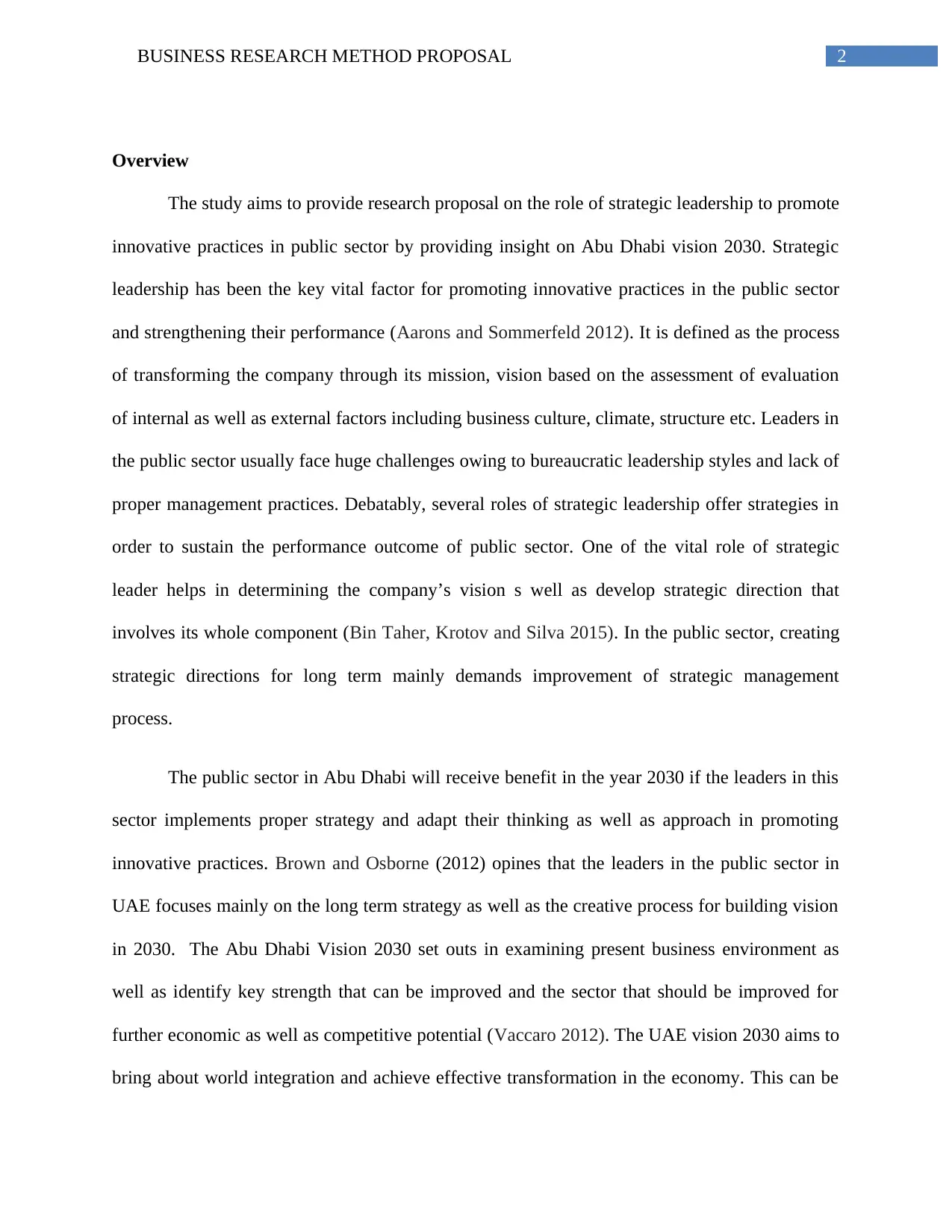
2BUSINESS RESEARCH METHOD PROPOSAL
Overview
The study aims to provide research proposal on the role of strategic leadership to promote
innovative practices in public sector by providing insight on Abu Dhabi vision 2030. Strategic
leadership has been the key vital factor for promoting innovative practices in the public sector
and strengthening their performance (Aarons and Sommerfeld 2012). It is defined as the process
of transforming the company through its mission, vision based on the assessment of evaluation
of internal as well as external factors including business culture, climate, structure etc. Leaders in
the public sector usually face huge challenges owing to bureaucratic leadership styles and lack of
proper management practices. Debatably, several roles of strategic leadership offer strategies in
order to sustain the performance outcome of public sector. One of the vital role of strategic
leader helps in determining the company’s vision s well as develop strategic direction that
involves its whole component (Bin Taher, Krotov and Silva 2015). In the public sector, creating
strategic directions for long term mainly demands improvement of strategic management
process.
The public sector in Abu Dhabi will receive benefit in the year 2030 if the leaders in this
sector implements proper strategy and adapt their thinking as well as approach in promoting
innovative practices. Brown and Osborne (2012) opines that the leaders in the public sector in
UAE focuses mainly on the long term strategy as well as the creative process for building vision
in 2030. The Abu Dhabi Vision 2030 set outs in examining present business environment as
well as identify key strength that can be improved and the sector that should be improved for
further economic as well as competitive potential (Vaccaro 2012). The UAE vision 2030 aims to
bring about world integration and achieve effective transformation in the economy. This can be
Overview
The study aims to provide research proposal on the role of strategic leadership to promote
innovative practices in public sector by providing insight on Abu Dhabi vision 2030. Strategic
leadership has been the key vital factor for promoting innovative practices in the public sector
and strengthening their performance (Aarons and Sommerfeld 2012). It is defined as the process
of transforming the company through its mission, vision based on the assessment of evaluation
of internal as well as external factors including business culture, climate, structure etc. Leaders in
the public sector usually face huge challenges owing to bureaucratic leadership styles and lack of
proper management practices. Debatably, several roles of strategic leadership offer strategies in
order to sustain the performance outcome of public sector. One of the vital role of strategic
leader helps in determining the company’s vision s well as develop strategic direction that
involves its whole component (Bin Taher, Krotov and Silva 2015). In the public sector, creating
strategic directions for long term mainly demands improvement of strategic management
process.
The public sector in Abu Dhabi will receive benefit in the year 2030 if the leaders in this
sector implements proper strategy and adapt their thinking as well as approach in promoting
innovative practices. Brown and Osborne (2012) opines that the leaders in the public sector in
UAE focuses mainly on the long term strategy as well as the creative process for building vision
in 2030. The Abu Dhabi Vision 2030 set outs in examining present business environment as
well as identify key strength that can be improved and the sector that should be improved for
further economic as well as competitive potential (Vaccaro 2012). The UAE vision 2030 aims to
bring about world integration and achieve effective transformation in the economy. This can be
⊘ This is a preview!⊘
Do you want full access?
Subscribe today to unlock all pages.

Trusted by 1+ million students worldwide

3BUSINESS RESEARCH METHOD PROPOSAL
attained by widening the public sector, enlarging enterprise base and developing external
markets.
Research Questions
The research questions are framed based on the above research proposal, which are given below;
Will strategic leadership help in improving the financial performance of the public sector
in Abu Dhabi in 2030?
Will strategic leadership help to promote innovative practices in public sector in Abu
Dhabi in 2030?
Can the leaders in public sector adopting proper strategy aid to establish balanced
company performance controls?
Does implementation of innovative practices through strategic leadership concept creates
challenges in the public sector?
Literature Review
Strategic leadership plays vital role in creating innovation culture in the public sector for
achieving change in delivery system in public service. Carter and Greer (2013) states that before
vision 2030, the restructuring of UAE government involved merger of various organizations in
the public sector for improving both coordination as well as efficiency. According to this vision
2030, this nation will build globally integrated, efficient and effective business environment by
streamlining government processes as well as business investment. In fact, the leaders in the
public sector of this nation will adopt proper strategies in order to promote innovative initiatives
at current vibrant business working conditions. In addition, application of strategic leadership
attained by widening the public sector, enlarging enterprise base and developing external
markets.
Research Questions
The research questions are framed based on the above research proposal, which are given below;
Will strategic leadership help in improving the financial performance of the public sector
in Abu Dhabi in 2030?
Will strategic leadership help to promote innovative practices in public sector in Abu
Dhabi in 2030?
Can the leaders in public sector adopting proper strategy aid to establish balanced
company performance controls?
Does implementation of innovative practices through strategic leadership concept creates
challenges in the public sector?
Literature Review
Strategic leadership plays vital role in creating innovation culture in the public sector for
achieving change in delivery system in public service. Carter and Greer (2013) states that before
vision 2030, the restructuring of UAE government involved merger of various organizations in
the public sector for improving both coordination as well as efficiency. According to this vision
2030, this nation will build globally integrated, efficient and effective business environment by
streamlining government processes as well as business investment. In fact, the leaders in the
public sector of this nation will adopt proper strategies in order to promote innovative initiatives
at current vibrant business working conditions. In addition, application of strategic leadership
Paraphrase This Document
Need a fresh take? Get an instant paraphrase of this document with our AI Paraphraser

4BUSINESS RESEARCH METHOD PROPOSAL
framework will also help the public sector to expand the stages of their strategic management in
four different ways, which includes-
Promote the involvement of the employees for creating the strategies
Map or design the business vision publicly
Empower the followers to lead
Push concrete networking as well as action
It has opined by Donate and de Pablo (2013) that, proper strategic leadership can be used as
an instrument for aligning business strategy as well as human resource (HR) practices in the
organization. In the present century and age of competitive environment, it is important that the
public sector should implement innovative practices as well as advanced technology for
producing creative product as well as services. In this nation, there have huge pace towards
innovation within the public sector that actively promotes introduction of commodity or service,
e-services, innovation of time as well as cost reduction.
An insight of Abu Dhabi’s vision 2030 highlights that the government of UAE adopts
program for the public sector innovation in order to provide training to the leaders of this sector.
For this program, strategic leadership plays important role in creating workshops, training
activities etc. This in turn helps in enhancing innovation culture in the public sector company. It
has been found by Elenkov, Judge and Wright (2015) that, strategic leadership also helps in
enhancing human capital through improvement in training, education, and other ways to improve
employability of nationals as well as competitiveness of workforce. Human capital mainly
relates to individuals skills as well as knowledge in the company. Joyce (2016) states that, in
framework will also help the public sector to expand the stages of their strategic management in
four different ways, which includes-
Promote the involvement of the employees for creating the strategies
Map or design the business vision publicly
Empower the followers to lead
Push concrete networking as well as action
It has opined by Donate and de Pablo (2013) that, proper strategic leadership can be used as
an instrument for aligning business strategy as well as human resource (HR) practices in the
organization. In the present century and age of competitive environment, it is important that the
public sector should implement innovative practices as well as advanced technology for
producing creative product as well as services. In this nation, there have huge pace towards
innovation within the public sector that actively promotes introduction of commodity or service,
e-services, innovation of time as well as cost reduction.
An insight of Abu Dhabi’s vision 2030 highlights that the government of UAE adopts
program for the public sector innovation in order to provide training to the leaders of this sector.
For this program, strategic leadership plays important role in creating workshops, training
activities etc. This in turn helps in enhancing innovation culture in the public sector company. It
has been found by Elenkov, Judge and Wright (2015) that, strategic leadership also helps in
enhancing human capital through improvement in training, education, and other ways to improve
employability of nationals as well as competitiveness of workforce. Human capital mainly
relates to individuals skills as well as knowledge in the company. Joyce (2016) states that, in

5BUSINESS RESEARCH METHOD PROPOSAL
order to develop and align with the company’s strategy as well as culture, the leaders in the
public sector should adopt proper strategic framework.
The vision of UAE 2030 highlights that, the government of Abu Dhabi has announced
long term plan for transforming this economy, which includes reducing reliance on oil sector or
other public sector as source of economic activities and more focus on knowledge based sector.
As emphasized by Ryan and Tipu (2013), strategic leadership will help in improving their
financial performance of the public sector through their innovative practices. This in turn will aid
them in achieving this vision. In addition, leadership issues are usually encountered in the public
sector that mainly occurs from lack of experience to implement this new vision outlined by the
federal government of UAE. From certain evidence, it has been seen that leaders of many
departments in public sector can encounter several problems owing to lack of experience in the
employees. However, inexperience in management of different department can also lead to
failure of implementing innovative practices within the sector. Therefore, as viewed Latham
(2013) that the organizations that are steered by the strategic leaders are highly successful in
accomplishing objectives of the public sector in long run.
Phipps (2016) observes that UAE is vigorously operating to promote innovation practices
in the public sector through policies as well as targeted initiatives. Moreover, strategic
leadership will play key role to promote innovation practices within the education and
telecommunication sector in this nation. The players in the telecommunication sector will be
well-positioned to improve this nation’s innovation ecosystem development goals by applying
their experience in technical field and commercializing innovation. It has been stated by
Mansour (2012) that, as education sector is one of the most important public sector, advanced
education system paves the way for social development as well as future progress of the
order to develop and align with the company’s strategy as well as culture, the leaders in the
public sector should adopt proper strategic framework.
The vision of UAE 2030 highlights that, the government of Abu Dhabi has announced
long term plan for transforming this economy, which includes reducing reliance on oil sector or
other public sector as source of economic activities and more focus on knowledge based sector.
As emphasized by Ryan and Tipu (2013), strategic leadership will help in improving their
financial performance of the public sector through their innovative practices. This in turn will aid
them in achieving this vision. In addition, leadership issues are usually encountered in the public
sector that mainly occurs from lack of experience to implement this new vision outlined by the
federal government of UAE. From certain evidence, it has been seen that leaders of many
departments in public sector can encounter several problems owing to lack of experience in the
employees. However, inexperience in management of different department can also lead to
failure of implementing innovative practices within the sector. Therefore, as viewed Latham
(2013) that the organizations that are steered by the strategic leaders are highly successful in
accomplishing objectives of the public sector in long run.
Phipps (2016) observes that UAE is vigorously operating to promote innovation practices
in the public sector through policies as well as targeted initiatives. Moreover, strategic
leadership will play key role to promote innovation practices within the education and
telecommunication sector in this nation. The players in the telecommunication sector will be
well-positioned to improve this nation’s innovation ecosystem development goals by applying
their experience in technical field and commercializing innovation. It has been stated by
Mansour (2012) that, as education sector is one of the most important public sector, advanced
education system paves the way for social development as well as future progress of the
⊘ This is a preview!⊘
Do you want full access?
Subscribe today to unlock all pages.

Trusted by 1+ million students worldwide
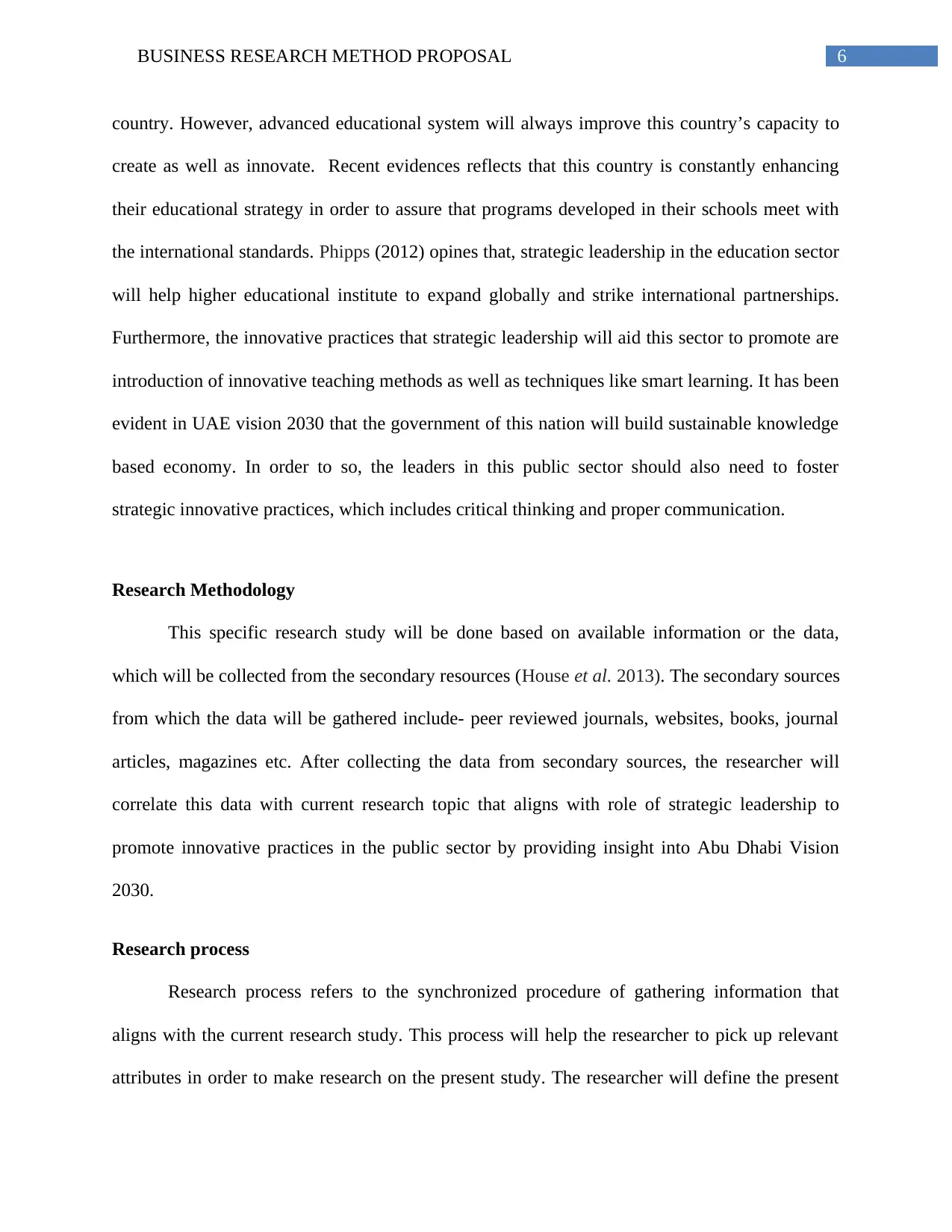
6BUSINESS RESEARCH METHOD PROPOSAL
country. However, advanced educational system will always improve this country’s capacity to
create as well as innovate. Recent evidences reflects that this country is constantly enhancing
their educational strategy in order to assure that programs developed in their schools meet with
the international standards. Phipps (2012) opines that, strategic leadership in the education sector
will help higher educational institute to expand globally and strike international partnerships.
Furthermore, the innovative practices that strategic leadership will aid this sector to promote are
introduction of innovative teaching methods as well as techniques like smart learning. It has been
evident in UAE vision 2030 that the government of this nation will build sustainable knowledge
based economy. In order to so, the leaders in this public sector should also need to foster
strategic innovative practices, which includes critical thinking and proper communication.
Research Methodology
This specific research study will be done based on available information or the data,
which will be collected from the secondary resources (House et al. 2013). The secondary sources
from which the data will be gathered include- peer reviewed journals, websites, books, journal
articles, magazines etc. After collecting the data from secondary sources, the researcher will
correlate this data with current research topic that aligns with role of strategic leadership to
promote innovative practices in the public sector by providing insight into Abu Dhabi Vision
2030.
Research process
Research process refers to the synchronized procedure of gathering information that
aligns with the current research study. This process will help the researcher to pick up relevant
attributes in order to make research on the present study. The researcher will define the present
country. However, advanced educational system will always improve this country’s capacity to
create as well as innovate. Recent evidences reflects that this country is constantly enhancing
their educational strategy in order to assure that programs developed in their schools meet with
the international standards. Phipps (2012) opines that, strategic leadership in the education sector
will help higher educational institute to expand globally and strike international partnerships.
Furthermore, the innovative practices that strategic leadership will aid this sector to promote are
introduction of innovative teaching methods as well as techniques like smart learning. It has been
evident in UAE vision 2030 that the government of this nation will build sustainable knowledge
based economy. In order to so, the leaders in this public sector should also need to foster
strategic innovative practices, which includes critical thinking and proper communication.
Research Methodology
This specific research study will be done based on available information or the data,
which will be collected from the secondary resources (House et al. 2013). The secondary sources
from which the data will be gathered include- peer reviewed journals, websites, books, journal
articles, magazines etc. After collecting the data from secondary sources, the researcher will
correlate this data with current research topic that aligns with role of strategic leadership to
promote innovative practices in the public sector by providing insight into Abu Dhabi Vision
2030.
Research process
Research process refers to the synchronized procedure of gathering information that
aligns with the current research study. This process will help the researcher to pick up relevant
attributes in order to make research on the present study. The researcher will define the present
Paraphrase This Document
Need a fresh take? Get an instant paraphrase of this document with our AI Paraphraser

7BUSINESS RESEARCH METHOD PROPOSAL
research idea that aligns with the topic on the role of strategic leadership in promoting innovative
practices within the public sector by providing insight on UAE’s vision 2030.
Research philosophy
Research philosophy aids the researcher to classify research principle by utilizing the
facet of the current research study. There are basically four major types of research philosophy,
which includes- positivism, pragmatism, realism and interpretivism.
Positivism explains about the scientific data collection and positive reality that is
acquired from empirical evidence. According to this philosophy, the data gathered is usually
interpreted by utilizing proper logic and reason, which forms the source of knowledge.
Interpretivism philosophy signifies the approach that considers individual’s emotional side in
future course of action. It is mainly associated to idealism and is used by applying qualitative
research. Realism philosophy indicates the philosophy that relies upon the reality facet, which is
independent of perceptions as well as beliefs (Panneerselvam 2014). Pragmatism philosophy aids
the researcher to assess the theories used in the research in form of realistic application. In this
research study, the researcher will be using interpretivism philosophy while conducting the
research as qualitative research will be utilized for gathering the information.
Research Design
Research design depicts the strategy that the researcher implements for amalgamating
different components of the study in logical manner. It will also help the researcher to analyze
different variables of the current research problem. There are three basic types of research design
including- exploratory, explanatory and descriptive. Exploratory research design facilitates the
researcher to explore as well as examine the condition for providing insight about the research
research idea that aligns with the topic on the role of strategic leadership in promoting innovative
practices within the public sector by providing insight on UAE’s vision 2030.
Research philosophy
Research philosophy aids the researcher to classify research principle by utilizing the
facet of the current research study. There are basically four major types of research philosophy,
which includes- positivism, pragmatism, realism and interpretivism.
Positivism explains about the scientific data collection and positive reality that is
acquired from empirical evidence. According to this philosophy, the data gathered is usually
interpreted by utilizing proper logic and reason, which forms the source of knowledge.
Interpretivism philosophy signifies the approach that considers individual’s emotional side in
future course of action. It is mainly associated to idealism and is used by applying qualitative
research. Realism philosophy indicates the philosophy that relies upon the reality facet, which is
independent of perceptions as well as beliefs (Panneerselvam 2014). Pragmatism philosophy aids
the researcher to assess the theories used in the research in form of realistic application. In this
research study, the researcher will be using interpretivism philosophy while conducting the
research as qualitative research will be utilized for gathering the information.
Research Design
Research design depicts the strategy that the researcher implements for amalgamating
different components of the study in logical manner. It will also help the researcher to analyze
different variables of the current research problem. There are three basic types of research design
including- exploratory, explanatory and descriptive. Exploratory research design facilitates the
researcher to explore as well as examine the condition for providing insight about the research
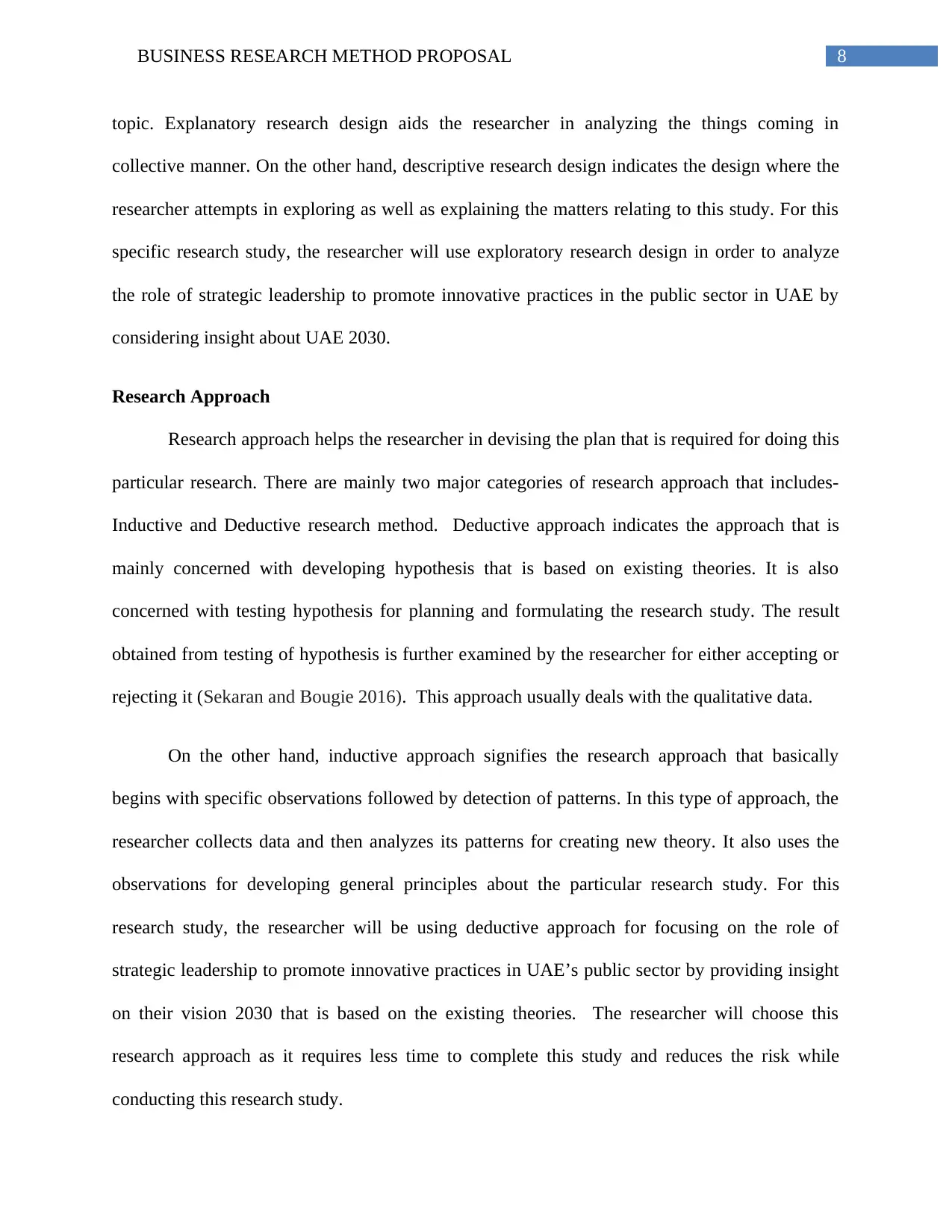
8BUSINESS RESEARCH METHOD PROPOSAL
topic. Explanatory research design aids the researcher in analyzing the things coming in
collective manner. On the other hand, descriptive research design indicates the design where the
researcher attempts in exploring as well as explaining the matters relating to this study. For this
specific research study, the researcher will use exploratory research design in order to analyze
the role of strategic leadership to promote innovative practices in the public sector in UAE by
considering insight about UAE 2030.
Research Approach
Research approach helps the researcher in devising the plan that is required for doing this
particular research. There are mainly two major categories of research approach that includes-
Inductive and Deductive research method. Deductive approach indicates the approach that is
mainly concerned with developing hypothesis that is based on existing theories. It is also
concerned with testing hypothesis for planning and formulating the research study. The result
obtained from testing of hypothesis is further examined by the researcher for either accepting or
rejecting it (Sekaran and Bougie 2016). This approach usually deals with the qualitative data.
On the other hand, inductive approach signifies the research approach that basically
begins with specific observations followed by detection of patterns. In this type of approach, the
researcher collects data and then analyzes its patterns for creating new theory. It also uses the
observations for developing general principles about the particular research study. For this
research study, the researcher will be using deductive approach for focusing on the role of
strategic leadership to promote innovative practices in UAE’s public sector by providing insight
on their vision 2030 that is based on the existing theories. The researcher will choose this
research approach as it requires less time to complete this study and reduces the risk while
conducting this research study.
topic. Explanatory research design aids the researcher in analyzing the things coming in
collective manner. On the other hand, descriptive research design indicates the design where the
researcher attempts in exploring as well as explaining the matters relating to this study. For this
specific research study, the researcher will use exploratory research design in order to analyze
the role of strategic leadership to promote innovative practices in the public sector in UAE by
considering insight about UAE 2030.
Research Approach
Research approach helps the researcher in devising the plan that is required for doing this
particular research. There are mainly two major categories of research approach that includes-
Inductive and Deductive research method. Deductive approach indicates the approach that is
mainly concerned with developing hypothesis that is based on existing theories. It is also
concerned with testing hypothesis for planning and formulating the research study. The result
obtained from testing of hypothesis is further examined by the researcher for either accepting or
rejecting it (Sekaran and Bougie 2016). This approach usually deals with the qualitative data.
On the other hand, inductive approach signifies the research approach that basically
begins with specific observations followed by detection of patterns. In this type of approach, the
researcher collects data and then analyzes its patterns for creating new theory. It also uses the
observations for developing general principles about the particular research study. For this
research study, the researcher will be using deductive approach for focusing on the role of
strategic leadership to promote innovative practices in UAE’s public sector by providing insight
on their vision 2030 that is based on the existing theories. The researcher will choose this
research approach as it requires less time to complete this study and reduces the risk while
conducting this research study.
⊘ This is a preview!⊘
Do you want full access?
Subscribe today to unlock all pages.

Trusted by 1+ million students worldwide
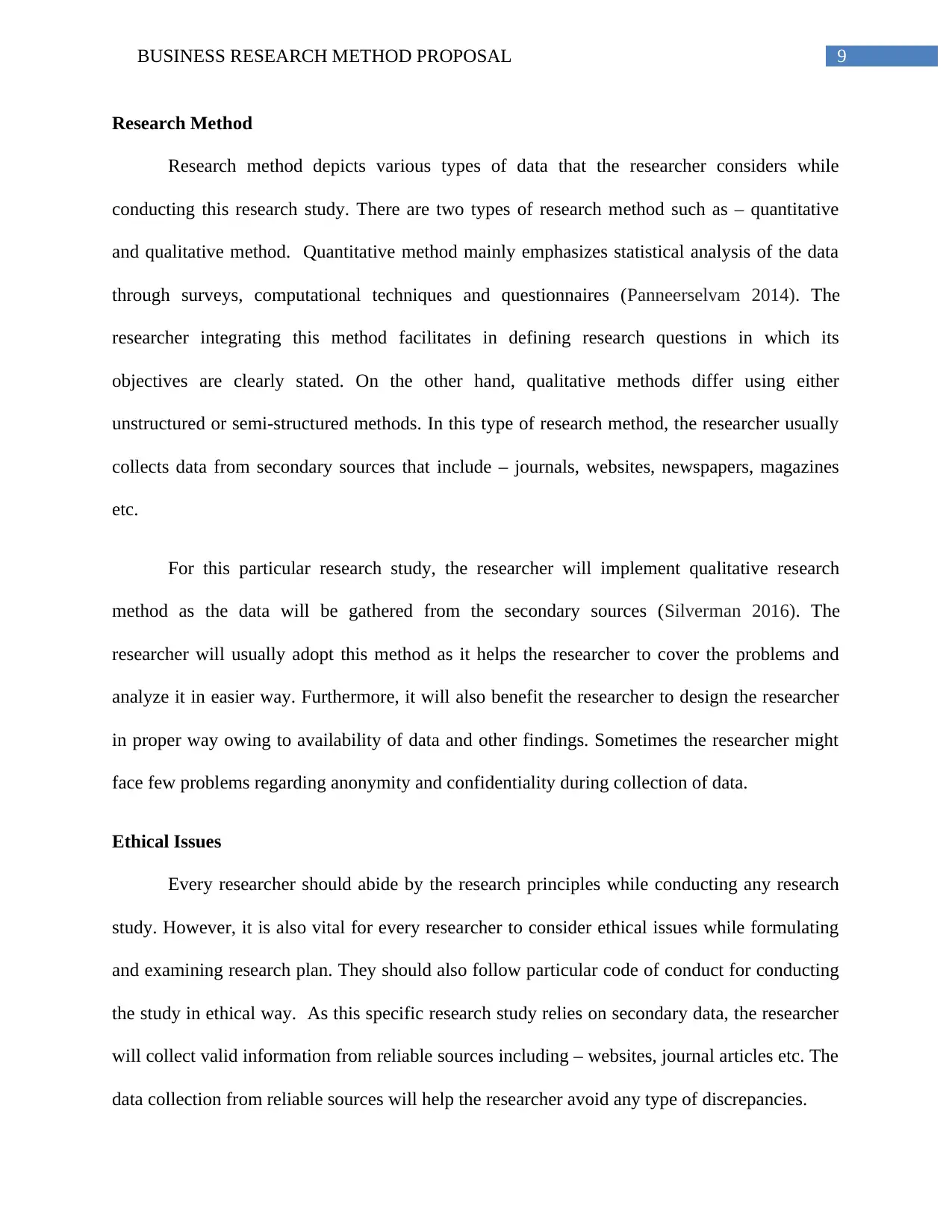
9BUSINESS RESEARCH METHOD PROPOSAL
Research Method
Research method depicts various types of data that the researcher considers while
conducting this research study. There are two types of research method such as – quantitative
and qualitative method. Quantitative method mainly emphasizes statistical analysis of the data
through surveys, computational techniques and questionnaires (Panneerselvam 2014). The
researcher integrating this method facilitates in defining research questions in which its
objectives are clearly stated. On the other hand, qualitative methods differ using either
unstructured or semi-structured methods. In this type of research method, the researcher usually
collects data from secondary sources that include – journals, websites, newspapers, magazines
etc.
For this particular research study, the researcher will implement qualitative research
method as the data will be gathered from the secondary sources (Silverman 2016). The
researcher will usually adopt this method as it helps the researcher to cover the problems and
analyze it in easier way. Furthermore, it will also benefit the researcher to design the researcher
in proper way owing to availability of data and other findings. Sometimes the researcher might
face few problems regarding anonymity and confidentiality during collection of data.
Ethical Issues
Every researcher should abide by the research principles while conducting any research
study. However, it is also vital for every researcher to consider ethical issues while formulating
and examining research plan. They should also follow particular code of conduct for conducting
the study in ethical way. As this specific research study relies on secondary data, the researcher
will collect valid information from reliable sources including – websites, journal articles etc. The
data collection from reliable sources will help the researcher avoid any type of discrepancies.
Research Method
Research method depicts various types of data that the researcher considers while
conducting this research study. There are two types of research method such as – quantitative
and qualitative method. Quantitative method mainly emphasizes statistical analysis of the data
through surveys, computational techniques and questionnaires (Panneerselvam 2014). The
researcher integrating this method facilitates in defining research questions in which its
objectives are clearly stated. On the other hand, qualitative methods differ using either
unstructured or semi-structured methods. In this type of research method, the researcher usually
collects data from secondary sources that include – journals, websites, newspapers, magazines
etc.
For this particular research study, the researcher will implement qualitative research
method as the data will be gathered from the secondary sources (Silverman 2016). The
researcher will usually adopt this method as it helps the researcher to cover the problems and
analyze it in easier way. Furthermore, it will also benefit the researcher to design the researcher
in proper way owing to availability of data and other findings. Sometimes the researcher might
face few problems regarding anonymity and confidentiality during collection of data.
Ethical Issues
Every researcher should abide by the research principles while conducting any research
study. However, it is also vital for every researcher to consider ethical issues while formulating
and examining research plan. They should also follow particular code of conduct for conducting
the study in ethical way. As this specific research study relies on secondary data, the researcher
will collect valid information from reliable sources including – websites, journal articles etc. The
data collection from reliable sources will help the researcher avoid any type of discrepancies.
Paraphrase This Document
Need a fresh take? Get an instant paraphrase of this document with our AI Paraphraser
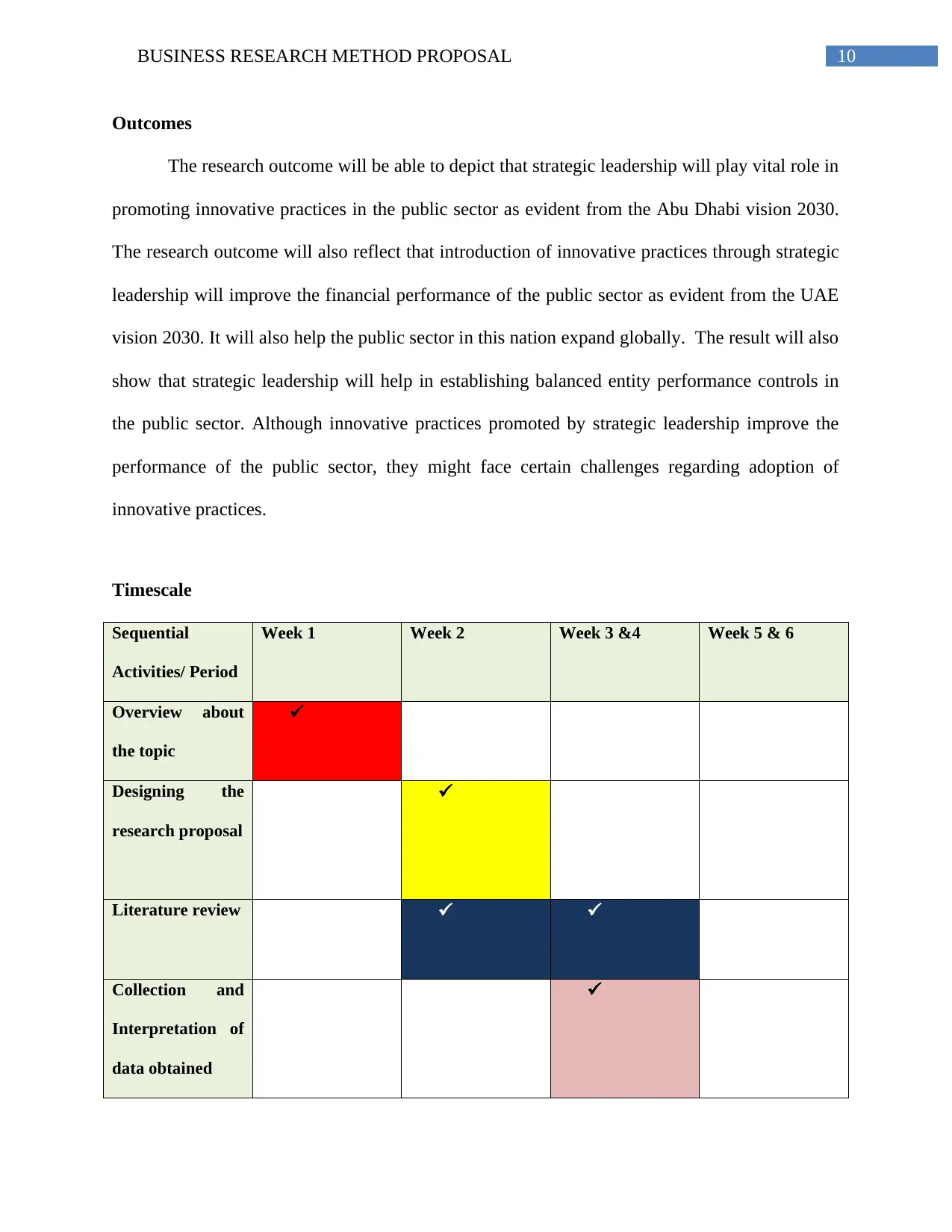
10BUSINESS RESEARCH METHOD PROPOSAL
Outcomes
The research outcome will be able to depict that strategic leadership will play vital role in
promoting innovative practices in the public sector as evident from the Abu Dhabi vision 2030.
The research outcome will also reflect that introduction of innovative practices through strategic
leadership will improve the financial performance of the public sector as evident from the UAE
vision 2030. It will also help the public sector in this nation expand globally. The result will also
show that strategic leadership will help in establishing balanced entity performance controls in
the public sector. Although innovative practices promoted by strategic leadership improve the
performance of the public sector, they might face certain challenges regarding adoption of
innovative practices.
Timescale
Sequential
Activities/ Period
Week 1 Week 2 Week 3 &4 Week 5 & 6
Overview about
the topic
Designing the
research proposal
Literature review
Collection and
Interpretation of
data obtained
Outcomes
The research outcome will be able to depict that strategic leadership will play vital role in
promoting innovative practices in the public sector as evident from the Abu Dhabi vision 2030.
The research outcome will also reflect that introduction of innovative practices through strategic
leadership will improve the financial performance of the public sector as evident from the UAE
vision 2030. It will also help the public sector in this nation expand globally. The result will also
show that strategic leadership will help in establishing balanced entity performance controls in
the public sector. Although innovative practices promoted by strategic leadership improve the
performance of the public sector, they might face certain challenges regarding adoption of
innovative practices.
Timescale
Sequential
Activities/ Period
Week 1 Week 2 Week 3 &4 Week 5 & 6
Overview about
the topic
Designing the
research proposal
Literature review
Collection and
Interpretation of
data obtained
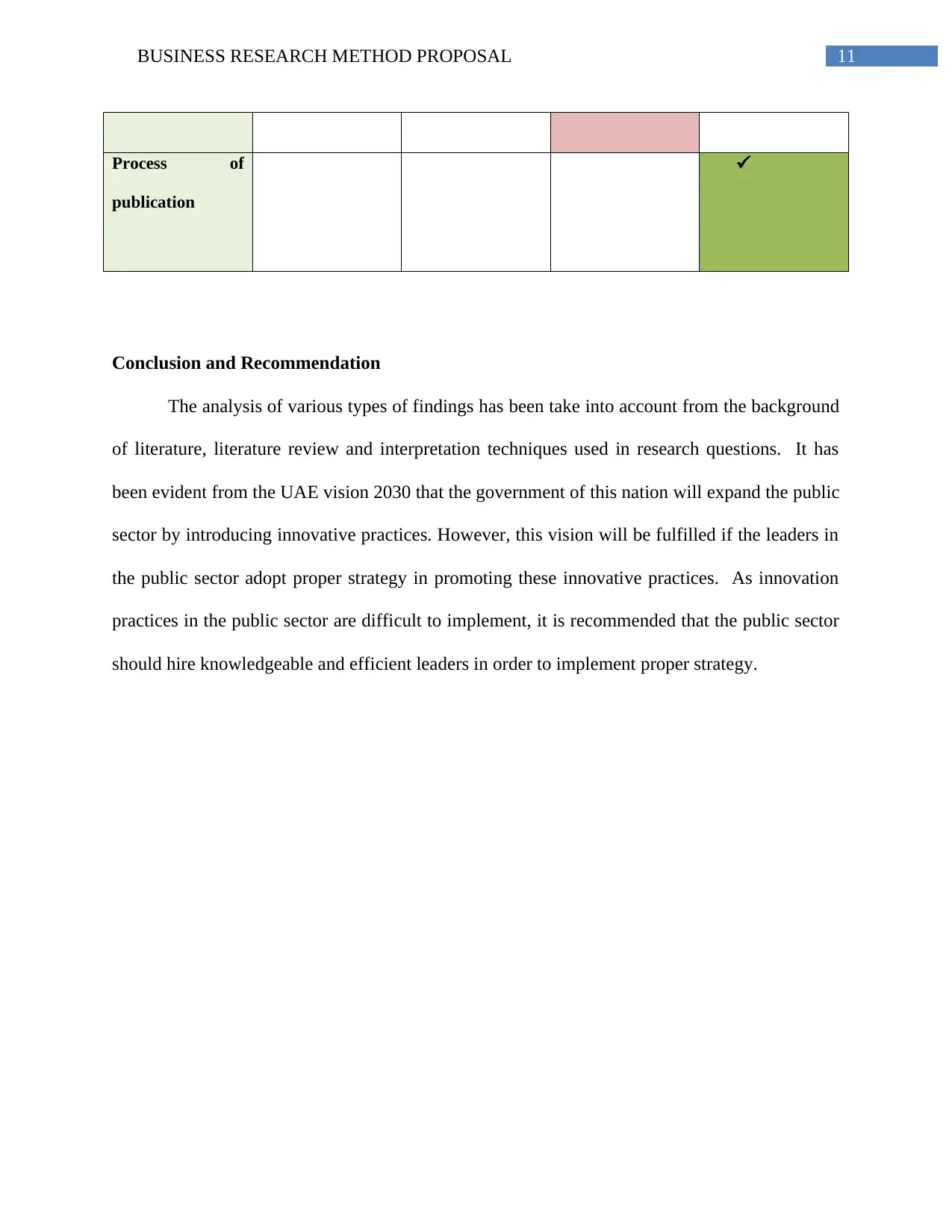
11BUSINESS RESEARCH METHOD PROPOSAL
Process of
publication
Conclusion and Recommendation
The analysis of various types of findings has been take into account from the background
of literature, literature review and interpretation techniques used in research questions. It has
been evident from the UAE vision 2030 that the government of this nation will expand the public
sector by introducing innovative practices. However, this vision will be fulfilled if the leaders in
the public sector adopt proper strategy in promoting these innovative practices. As innovation
practices in the public sector are difficult to implement, it is recommended that the public sector
should hire knowledgeable and efficient leaders in order to implement proper strategy.
Process of
publication
Conclusion and Recommendation
The analysis of various types of findings has been take into account from the background
of literature, literature review and interpretation techniques used in research questions. It has
been evident from the UAE vision 2030 that the government of this nation will expand the public
sector by introducing innovative practices. However, this vision will be fulfilled if the leaders in
the public sector adopt proper strategy in promoting these innovative practices. As innovation
practices in the public sector are difficult to implement, it is recommended that the public sector
should hire knowledgeable and efficient leaders in order to implement proper strategy.
⊘ This is a preview!⊘
Do you want full access?
Subscribe today to unlock all pages.

Trusted by 1+ million students worldwide
1 out of 15
Related Documents
Your All-in-One AI-Powered Toolkit for Academic Success.
+13062052269
info@desklib.com
Available 24*7 on WhatsApp / Email
![[object Object]](/_next/static/media/star-bottom.7253800d.svg)
Unlock your academic potential
Copyright © 2020–2025 A2Z Services. All Rights Reserved. Developed and managed by ZUCOL.





